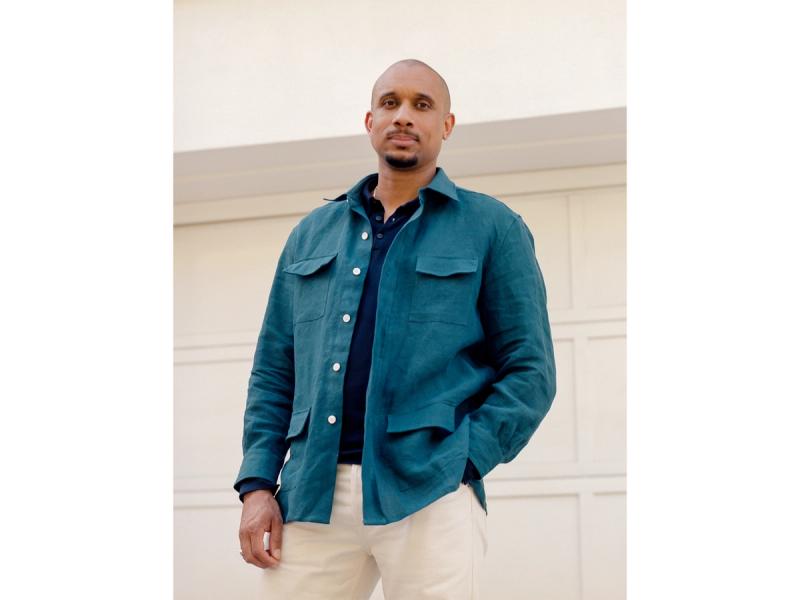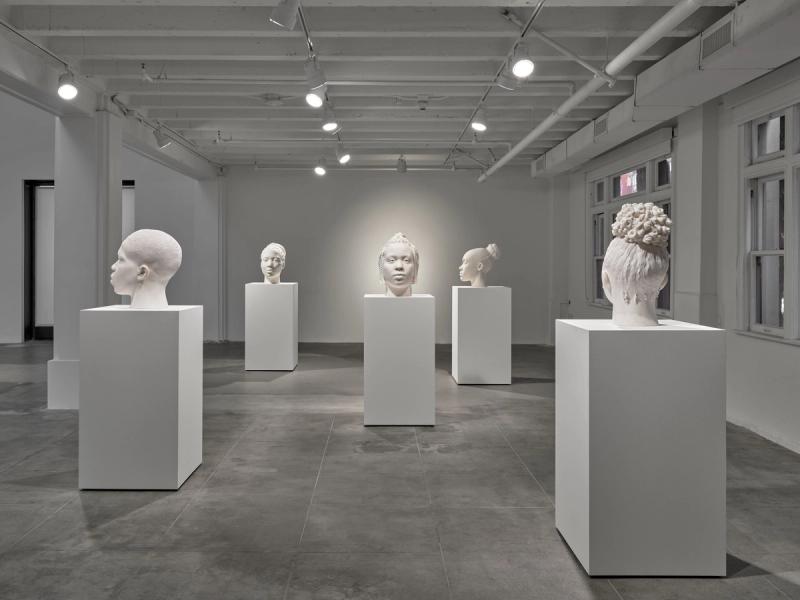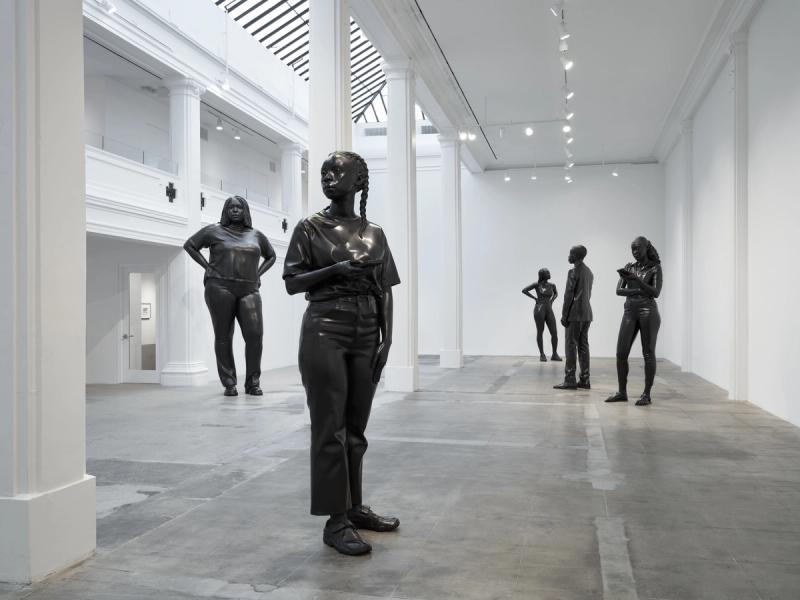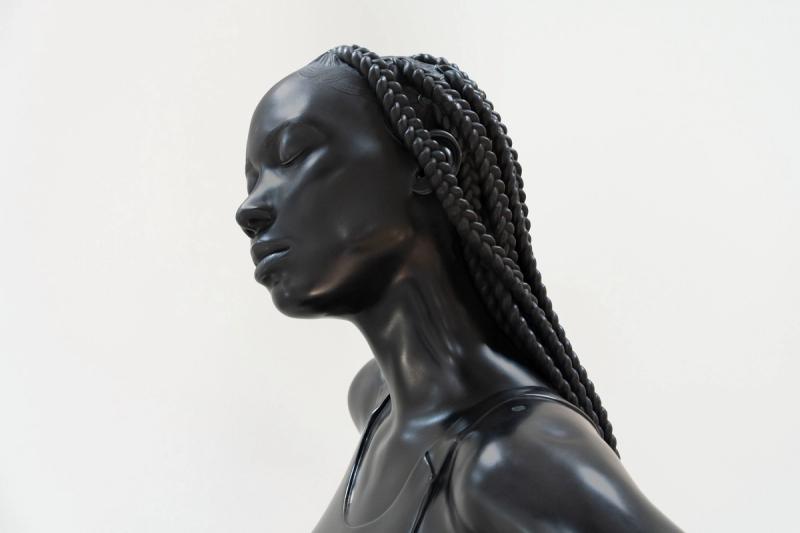
With His Monumental Bronze Sculptures, Thomas J Price Honors the Everyday Features of Black Life
In the ebb and flow of history, civilizations have long endured through sculpture, the distillation of a society’s values into painstakingly carved metal and stone. Apart from what they tell us about the heroes and mythologies of a given culture, sculptures also preserve the tacit implications of beauty standards, prejudices, and glaring omissions that frequently contradict the values of modern-day progressive societies. At Hauser & Wirth’s Downtown Los Angeles gallery, “Beyond Measure,” an exhibition of new and early works by the British artist Thomas J Price (on view through Aug. 20), presents monuments of a subject almost wholly excluded from the sculptural canon: the casual, absolutely ordinary features of Black life.
Standing nine to twelve feet high, Price’s five newly cast bronzes depict Black figures eschewing gallant poses or any formal regalia. Instead, four women (plus one young man in a suit) wear Crocs, sandals, and various forms of athleisure as they casually gaze into the distance or down at a smartphone. Seemingly preoccupied, they exhibit a pointed lack of interest in performing for an audience, making the surrounding viewers look comically, almost insignificantly, small.
Nonchalance is the point, according to Price. “They’re absorbed in oneself and not trying to project an image of oneself,” he says. “They’re not interested in the viewer.”

For a little over two decades, Price has made sculpture that questions cultural perceptions of the “other,” tacitly dissecting both implicit and explicit expressions of anti-Blackness. In works that range from small-scale acrylic busts to monumental figures in marble or bronze, each piece is an amalgamation of features he’s encountered: facial expressions, postures, and stances borrowed from models, magazines, ancient sculptures, and beyond. Price refers to these composite works as psychological portraits, “fictional people depicting real moments, real psychologies, and real moments of being,” he says, in which subtleties of posture and expression offer hints to the complexities of the inner life.
Unlike traditional monuments that embody specific historical lessons, the deliberate ambiguity of identity and meaning in Price’s sculptures has the potential to trigger empathy, “inviting us to perhaps imagine who this individual is, and furthermore project ourselves into their story,” says Dhyandra Lawson, an assistant curator at the Los Angeles County Museum of Art. A poignant example is “Plain to See” (2015), a bronze sculpture that depicts a Black man wearing a hoodie, one hand in his pocket, the other holding his phone. Completed two years after George Zimmerman was acquitted for the murder of Trayvon Martin, the piece’s relatively mundane details reference the suspicions of criminality dangerously projected onto Black men and boys. With such projection in mind, Price invites viewers to make of his works what they will. “It’s a chance to freely explore what you’re seeing, the things you’ve been taught, and the attitudes that you’ve learned.”
In contrast to the conversations at the intersection between racism and sculpture in the United States—which primarily revolve around the removal of Confederate monuments—Price looks further back in time to European classicism, highlighting a throughline from our contemporary prejudices to physiognomy, a pseudoscience that equated facial features with personal character. Whereas Aristotle believed that large-headed people were inherently mean, sculptors and artists during the age of European Imperialism weaponized physiognomy as a built form of white supremacy. Adopting the sculptural traditions of those eras, Price subverts expectations of value by distorting scale and materiality as he centers the Black figure in his work. His first composite sculpture and first publicly exhibited work, the ambiguously titled “Mixed Feelings About Bus Drivers” (2004), sits unassumingly in the far corner of the gallery, a small, Roman-style bust of a Black man resting on a shelf made of a scrap of wood, and mounted on the wall with a single screw. It was first shown as the sole work he presented on the expansive white wall of a student show in 2004. “That was a big statement by a small object,” he recalls, “in terms of navigating ideas of power in that space, and who we expect to see represented in certain ways.”
Since sculpting his earliest works from clay by hand, Price has more recently scaled up, not only in terms of size, but also material and process. The monumental works at Hauser & Wirth began with open calls for models from both his native London and L.A., whose bodies were then 3-D scanned and digitally remixed, and their likenesses reproduced by metalworkers. He asked his models to wear whatever they wanted and to stand however they felt comfortable. “These works chime against the lazy tropes that are often the avenue to visibility,” Price says—referring namely to the need for Black people to perform, and perform exceptionally, in order to be valued by society. “This is really a show about naturalism, and in a very literal sense, taking up space on one’s own terms.”

The largest sculpture, “Grounded in the Stars,” is a 12-foot-tall rendition of a young Black woman wearing a plain T-shirt and braids that fall into a neat bob around her face, standing in the slightest contrapposto, with both hands on the back of her hips. For Price, both her stature and her unbothered gaze are markers of status and authority; this is a figure who understands her worth.




